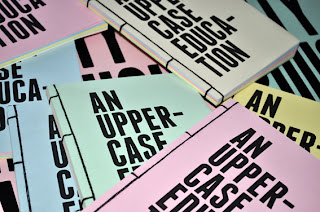(I will try to recite what I wrote before).
The best way to tackle this feedback will be to go through the notes I took while listening to others and then discuss the further issues in more depth. Also I would like to apologise to the group for having to endure my waffle. My thoughts are usually a bit wordy and boring, which I why I tend not to share them, however I assure you that in the end they do make some coherent sense. Apparently my speaking skills just weren’t switched on today. OK!
Notes
· The context book is a distilled / focused version of our context blogs.
· I should test my questionnaire before sending it off to studios.
· My personality should come through in the questions, this will inform the tone and the responses.
· Interview would benefit from being focused on a particular subject. For example, typography in communication, and the clarity of successfully using a grid.
· Studio work will be selected on the basis of what I interpret the piece of work that optimises their practice and ideology. This could be typographic, engaging with culture or just a very successful piece of communication.
· Consider the sections of the book and how the shift of focus should be immediate. This could be kicked off with key quotes that set a tone of clarity, objectivity or creativity.
· Interviews and questions can be broken up to help aid the structure of the book and the chapters. The structure should lead somewhere and ultimately leave the reader questioning what the already know.
· A case study of how typography has been used on a large scale project to effectively communicate and engage with culture.
Ok so those were the notes, now for a little more detail and suggested direction.
I was cut down a bit for planning too far ahead and having too much of an idea of what I wanted the final article to be, which yes I did, but in my mind a final outcome isn’t something to work towards, but just a physical impression of what my thoughts are. It gives substance to though, from which further evaluations can be made. Without drawing out my initial sketches I would no have know for example that the 3 sections I had broken the book into may not be as effective as say using sub-sections within those main 3. Anyway… form follows function bla bla. I know what the content is; it is answers, interviews and quotes. The tone and content will inform the design direction. Annnnnnyway.
A good piece of feedback, which I am greatly in favour for, is that of the pub discussion. I should gather us a few mates with a pint and raise some of the issues I would be asking the studios and designers. This way a discussion may boil my questions down to just a few core ideas that need exploring.
Also I need to make it clear at this stage what it is about the sections that will create a clear thread throughout the book. The content will drive this.
Something interesting that will certainly drive the tone of the book is asking designers about their worst clients who have basically made them push aside their awesome deign in favour of what the client think is best for them. Basically I need to provoke some emotional response from the designers in order for this to be successful. After all when was the last time you spoke to a designer who didn’t want to bitch about their worst client?
CLIENT Vs DESIGNER
A question may be something like; ‘what is your worst case of a client ruining a brilliant concept and execution of a project?’
This can also lead to interesting questions such as; ‘what have you done in these situations to persuade or advise the client.’
TENSION & CONFLICT
Creating a dialogue and understanding between the designer and the client will be very fruitful, while the tone will be fun to read as the personalities of pissed off designers will come through heavily.
Another idea is to talk to the wider creative sectors, basically my friend group, which consists of a film-maker, photographers, an illustrator and a copywriter (among other graphic designers obviously). This shows that we are all connected by one thing, annoying clients. Again, what designer wouldn’t want to hear about that? All this will lead to further debate and clarification of questions.
Finally the idea of talking to the clients isa fun one. The opposed perspective could being to light whether they are happy with what they received, what their input on the design was, or whether they feel the designer indulged themselves in an ego trip and produced an utterly non-objective piece of work.
COMMERSE Vs DESIGN
(I must try to remain impartial, however unlikely it sounds).
























































